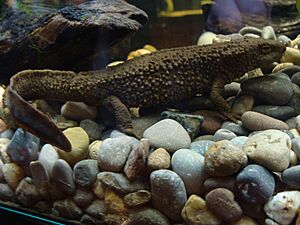Hong Kong warty newt facts for kids
Quick facts for kids Hong Kong warty newt |
|
|---|---|
 |
|
| Conservation status | |
| Scientific classification | |
| Genus: |
Paramesotriton
|
| Species: |
hongkongensis
|
The Hong Kong warty newt is a special type of salamander. It is also known as the Hong Kong newt. Its scientific name is Paramesotriton hongkongensis.
This newt was first thought to live only in Hong Kong. But scientists have now found it in coastal areas of Guangdong Province too. It is the only type of newt or salamander (called Urodela) that lives in the wild in Hong Kong.
Some experts think this newt is a type of Paramesotriton chinensis. However, others disagree. They point out that the two newts live in different places. They also look different and prefer different homes.
Contents
What Does the Hong Kong Warty Newt Look Like?
The Hong Kong warty newt is about 11 to 15 centimeters long. This length is measured from its nose to the tip of its tail. Its body can be light brown or dark brown. It has bright orange spots on its belly, which is its underside.
Unique Markings
Each newt has its own special pattern of orange spots. These patterns are like human fingerprints. They are unique to every single newt. The newt's skin also has small bumps, like tiny granules.
Body Features
A raised line of skin runs down its back. It starts from the neck and goes partway down the tail. The newt also has two folds of skin on its sides. These are called dorsolateral folds.
Its head is shaped like a triangle. The newt's eyes have pupils that look like a straight line. Its tail is thin and flat. It has a thin red stripe along the bottom edge of the tail. All four legs are about the same size. The front legs have four toes, and the back legs have five toes. None of these toes are connected by skin.
Young Newts and Metamorphosis
Like other newts, young newts are called tadpoles. They have finger-like gills around their necks. These gills help them breathe underwater. After they grow up, they go through a big change called metamorphosis. During this change, their gills disappear completely.
How Newts Protect Themselves
When the newt feels scared, it has a special way to protect itself. It can release a liquid that is toxic, or poisonous. It might also pretend to be dead. It rolls onto its back to show its bright orange belly. This bright color warns predators that it is poisonous.
Reproduction and Life Cycle
During the time when newts mate, the male newt does a special dance. It beats its tail to attract a female. Its tail also grows a white or bluish stripe. This stripe can be seen even in dim light. The female newt lays her eggs one by one. She carefully wraps each egg in a leaf to keep it safe.
Protecting the Hong Kong Warty Newt
In Hong Kong, the Hong Kong warty newt is a protected species. This means it is against the law to harm or catch them. This protection is under the Wild Animals Protection Ordinance Cap 170.


